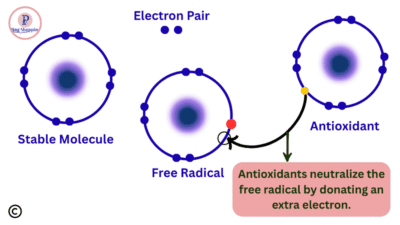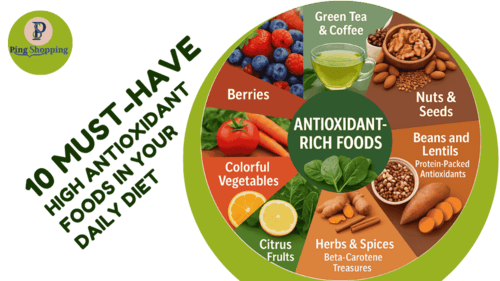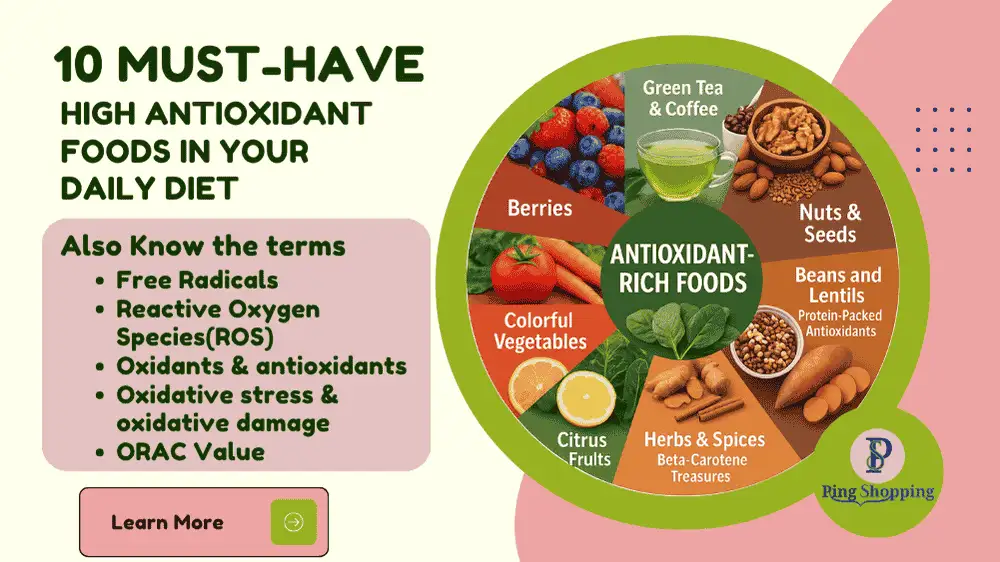Before discussing the 10 must-have daily foods that have high antioxidants, this article is going to clear all the doubts about the terms in detail.
Before reading this article in depth, one must understand the following terms: Free Radicals, Oxidative Stress, Oxidative Damages, ROS(Reactive Oxygen Species), Oxidants, Anti-Oxidants, Cellular Health, Cellular Damages, ORAC Measurement, etc.
Table of Contents
What are Free Radicals?
To understand free radicals, an elementary knowledge of chemistry is required.
Atoms are surrounded by shells, and a definite number of electrons is in each shell. First, the innermost shell is filled with electrons, and then electrons begin filling the next shell. In this way, if the outermost shell is completely filled with electrons, then the atom is neutral, that is, neither positive nor negative.
If an atom’s outer shell is not full, it may bond with another atom, using the electrons to complete its outer shell. These types of atoms are known as free radicals.
Atoms with a full outer shell are stable, but free radicals are unstable, and in an effort to make up the number of electrons in their outer shell, they react quickly with other substances.
When oxygen molecules split into single atoms that have unpaired electrons, they become unstable free radicals that seek to bond with other atoms or molecules.
Free radicals are unstable, highly reactive molecules with at least one unpaired electron. The body makes them during normal metabolism, but they can also form from outside sources. The body needs some free radicals for key functions. However, when levels become too high, they can damage cells, leading to oxidative stress.
Reactive Oxygen Species(ROS)
Simply, reactive oxygen species, or ROS, are a subset of free radicals that contain oxygen. A few of the most common reactive oxygen species include hydroxyl radical, superoxide anion, and hydrogen peroxide (H2O2). Through the process of oxidative phosphorylation, mitochondria are the greatest producers of superoxide anion and subsequently hydrogen peroxide. Cells with high metabolic rates produce greater amounts of ROS. Reactive nitrogen species (RNS) are an example of non-ROS free radicals. Nitric oxide (NO) is the most common RNS.
What are oxidants?
Oxidants in the body are reactive molecules, often called free radicals, produced during normal metabolism or from external sources like pollution and UV radiation. When their levels are too high, they can damage cells, proteins, and DNA, a state known as oxidative stress, which is linked to aging and various diseases like cancer and heart disease. The body uses antioxidants to neutralize these oxidants and protect against damage.
Oxidants are formed as a normal product of aerobic metabolism but can be produced at elevated rates under pathophysiological conditions. Antioxidant defense involves several strategies, both enzymatic and non-enzymatic.
The free radical oxidants, such as reactive oxygen species, reactive nitrogen species, and reactive sulfur species, are produced inside cells through various metabolic processes. The body is equipped with an antioxidant defense system that guards against oxidative damage caused by these reactive oxidants and plays a major role in protecting cells from oxidative stress and damage.
What are antioxidants?
Antioxidants are molecules that can help your body fight off harmful free radicals, which have been linked to health conditions like diabetes and cancer. Antioxidants are substances that can prevent or slow down the damage to cells caused by free radicals.
Antioxidants such as glutathione (GSH), thioredoxin, ascorbic acid, and enzymes, for example, superoxide dismutase (SOD), glutathione peroxidase (GPx), and catalase (CAT), counteract oxidative stress and protect lipids, proteins, and DNA. Antioxidants such as tocopherols, ascorbic acid, carotenoids, flavonoids, and amino acids are also natural antioxidants present in foods.
Free radicals are highly reactive and unstable molecules that are produced in the body naturally as a byproduct of metabolism (a chemical reaction in the body cells that changes food into energy) or by exposure to toxins in the environment, such as pollution, attacks from external microbes such as bacteria/viruses, and ultraviolet light. If the body cannot process and remove free radicals efficiently, oxidative stress can result. This oxidative stress can harm cells and body functions. This will result in a compromise with the immunity of body.
What is Oxidative Stress?
Oxidative stress is an imbalance in the body where there are too many free radicals and not enough antioxidants to neutralize them. This imbalance occurs when the body’s natural antioxidant defense system is overwhelmed, leading to damage to cells, proteins, lipids, and DNA. This can contribute to aging and the development of chronic diseases such as cancer, heart disease, and neurodegenerative disorders.
What are oxidative damages?
Oxidative damage is the harm to cells and tissues caused by an excess of unstable molecules called free radicals or reactive oxygen species (ROS). When ROS production outpaces the body’s antioxidant defenses, it leads to an imbalance known as oxidative stress, which damages important cellular components like proteins, DNA, and lipids. This damage can impair cell function, contribute to aging, and play a role in diseases like cancer. Severe oxidative damage can lead to cell death.
How can it be managed?
- Healthy lifestyle: Adopting a diet rich in antioxidants and avoiding risk factors like smoking, drinking, and exposure to pollutants can help reduce oxidative stress.
- Antioxidant defense system: The body naturally has a system of antioxidants to combat ROS, but this can be overwhelmed by excessive free radical production.
What are cellular health and cellular damage?
Cellular health
- Cellular health refers to a cell’s ability to function optimally and maintain its structure.
- Proper cellular health depends on adequate nutrition, oxygen supply, hydration, functional mitochondria (the cell’s powerhouses), and stable DNA. Adequate healthy cells are essential for the proper functioning of tissues, organs, body mechanisms, and metabolism.
Cellular damage
- Cellular damage refers to the disruption of proper cellular functions due to external or internal factors like toxins, lack of oxygen (hypoxia), infection, oxidative stress from free radicals, and physical trauma.
- Types: Damage can be reversible if the stress is minor and temporary, but it becomes irreversible if it is severe or prolonged. If damage is irreversible, the cell can die through processes like necrosis or apoptosis, which are linked to various diseases.
How are free radicals formed?
Free radicals are an unavoidable byproduct of many normal bodily functions, as well as exposure to external factors.
Internal sources
- Mitochondrial activity: The process of converting oxygen into cellular energy (ATP) in the mitochondria is a major source of free radical formation.
- Inflammation and immune response: Immune cells deliberately produce free radicals, such as hydrogen peroxide, to destroy invading bacteria and viruses.
- Metabolic processes: Normal metabolic activities like breathing and digestion produce free radicals.
- Exercise: Strenuous or excessive exercise can temporarily increase free radical production.
External sources
- Environmental toxins: Exposure to air pollutants, pesticides, and industrial chemicals can create free radicals.
- Smoking and drinking: Tobacco smoke and alcoholic drinks are a significant source of free radicals.
- Radiation: Overexposure to radiation, including ultraviolet (UV) light from the sun, i.e., sunbathing, creates free radicals.
- Diet: An unhealthy diet of processed foods, excessive alcohol, sugar, and unhealthy & processed fats can produce free radicals.
The dual role of free radicals
Free radicals are not inherently bad; at low or moderate levels, they play a vital role in important physiological functions.
Beneficial functions:
- Fighting pathogens: The immune mechanism uses free radicals to neutralize or kill foreign invaders such as bacteria and viruses.
- Cell signaling: Since they have at least one unpaired electron or multiple free electrons, they act as chemical messengers in the brain and are involved in other cellular signaling pathways.
- Hormone production: Free radicals are necessary for the production of some hormones, such as thyroid hormone.
Harmful effects (Oxidative Stress):
When free radical levels become too high, they overwhelm the body’s natural defenses, leading to oxidative stress and cellular damage.
When free radical levels become too high, they overwhelm the body’s natural defenses, leading to oxidative stress and cellular damage.
- To become stable, free radicals take electrons from healthy molecules. This process damages cell membranes, proteins, lipids, and DNA.
- Aging: The accumulated oxidative damage from free radicals is believed to be a major contributor to the aging process.
- Oxidative stress is linked to many chronic and degenerative diseases, including:
- Cancer
- Cardiovascular disease and atherosclerosis
- Alzheimer’s and Parkinson’s diseases
- Diabetes
- Rheumatoid arthritis
- Cataracts
How the body fights free radicals

The body’s defense against excess free radicals and oxidative stress is an internal system of antioxidants.
- Antioxidant enzymes: The body produces its own antioxidant enzymes, such as superoxide dismutase (SOD) and catalase, which detoxify free radicals.
- Dietary antioxidants: Humans must get additional antioxidants from their diet. Antioxidants donate an electron to a free radical, neutralizing it and breaking the chain reaction of damage. Good sources include fruits, vegetables, nuts, and seeds rich in:
- Vitamins A, C, and E
- Beta-carotene
- Polyphenols
- Minerals like selenium, copper, and zinc
A healthy lifestyle that minimizes exposure to external toxins, includes a balanced diet rich in antioxidants, and incorporates regular, moderate exercise is key to managing free radical levels and reducing oxidative stress.
ORAC Measurement:
ORAC stands for Oxygen Radical Absorbance Capacity
ORAC is the measuring unit of the strength of an Antioxidant
Now, the question that can arise is how one can know the right quantity of Antioxidants in our daily diet? The answer is the Oxygen Radical Absorbance Capacity (ORAC) of an Antioxidant.
The power and strength of an Antioxidant product is measured with a value known as ORAC. It is the unit that measures the capability of an antioxidant to neutralize Free Radicals. The higher the ORAC value, the stronger the Antioxidant capacity of a particular antioxidant or food.
The antioxidant capacity of an antioxidant or food is measured in ORAC.
Now, let us dive into the 10 must-have daily foods that are powerhouses of antioxidants.

In our modern world, where environmental toxins, pollutants, processed foods, and chronic stress, strenuous work constantly challenge our cellular health, leading to a decline in the overall health of the body, mind, and memory.
Antioxidants are substances that play a vital role in defending against the harmful effects of free radicals. These powerful compounds neutralize harmful free radicals, protect against chronic diseases, and support optimal health throughout our lives.
In this article, we list 10 must-eat foods that are high in antioxidants and can revitalize your unhealthy life into an energetic and healthy one.
1. Berries (Blueberries, Strawberries, Raspberries)
Berries are antioxidant powerhouses. For example, blueberries and strawberries are rich in anthocyanins (purple pigments) and vitamin C, which help fight oxidative damage and inflammation. Berries are low in calories but high in fiber and nutrients, making them an ideal daily snack or topping for yogurt and oatmeal.
Blueberries(Recommended): The Antioxidant Champions
Blueberries are the king of the antioxidant kingdom. Its astounding ORAC value is approximately 13400 antioxidants per cup, making it one of nature’s most abundant sources of antioxidants.
Research demonstrates that regular blueberry consumption can improve memory and cognitive function, reduce DNA damage, lower blood pressure, and provide significant cardiovascular health. The antioxidants in blueberries have been shown to neutralize free radicals that contribute to aging and may help protect against cancer development.
2. Green Tea & Coffee
Tea and coffee are surprising antioxidant sources. Green tea provides catechins (especially EGCG), powerful polyphenols that protect cells. Similarly, a cup of coffee contains hundreds of antioxidant compounds absorbed from the beans. In fact, in Western diets, coffee often provides more total antioxidants than fruits and vegetables combined. Regularly drinking unsweetened green tea or moderate coffee (without excess sugar) can significantly boost your intake of natural antioxidants and is linked to lower disease risk.
Green Tea(Recommended): Ancient Wisdom, Modern Science
Green tea stands out as one of the most researched antioxidant beverages, containing approximately 1,300 micromoles of ORAC per gram of dried leaves. The primary antioxidant compound, epigallocatechin-3-gallate (EGCG), along with other catechins, provides exceptional cellular protection.
Daily green tea consumption increases plasma antioxidant capacity by up to 15.6%. The polyphenols in green tea demonstrate powerful anti-inflammatory effects, support cardiovascular health, enhance immune function, and may reduce cancer risk. Research suggests that drinking 3-4 cups daily provides optimal antioxidant benefits without excessive caffeine intake.
3. Nuts & Seeds (Walnuts, Almonds, Flaxseed)
Nuts and seeds are antioxidant-rich plant fatty foods. For example, walnuts and almonds contain high levels of polyphenols and vitamin E that protect cell membranes from oxidative damage. Studies show that eating walnuts or almonds raises blood antioxidant levels and even reduces oxidized LDL (“bad” cholesterol). Flaxseeds and chia seeds add additional antioxidants (and omega-3 fatty acids) as well as fiber. Because nuts have healthy fats, they also help absorb fat-soluble antioxidants (like vitamin E and carotenoids from other foods).
Walnuts(Recommended): Brain Food with Antioxidant Power
Walnuts possess the highest antioxidant activity among all common nuts, with an approximate ORAC value of 13,500 per 100 grams. These brain-shaped nuts contain unique combinations of vitamin E, melatonin, and polyphenol contained in their papery skins.
Beyond their antioxidant properties, walnuts provide 2.5 grams of omega-3 fatty acids per ounce, making them exceptional for cardiovascular and brain health. Daily walnut consumption has been shown to improve cholesterol profiles, reduce inflammation, enhance cognitive function, and support healthy aging. Just one ounce daily provides significant health benefits without weight gain.
Also Read:
Best diet plan for weight loss in 30 days
Weight Loss diet plan with high fiber and protein, 10 super foods in a healthy way.
4. Colorful Vegetables (Tomatoes, Carrots, Red Peppers)
Brightly colored vegetables contain carotenoid antioxidants. For example, tomatoes are loaded with lycopene, a potent antioxidant carotenoid linked to lower cancer and heart disease risk. Fresh tomatoes contain 1-8 mg of lycopene per 100 grams, while processed products like tomato paste and ketchup concentrate levels to 16-17 mg per 100 grams. Similarly, carrots and red peppers provide beta-carotene (a Vitamin A precursor), which is a powerful antioxidant. These carotenoids protect tissues and eyes (beta-carotene even helps block UV damage). Cooking these veggies with a little oil (or eating them raw) allows you to absorb their antioxidants more effectively.
Tomatoes: Lycopene’s Natural Source
Lycopene demonstrates singlet-oxygen-quenching ability twice as high as beta-carotene and ten times higher than vitamin E. This potent antioxidant has been linked to reduced prostate cancer risk, improved cardiovascular health, and protection against various chronic diseases. Cooking tomatoes with healthy fats increases lycopene absorption by up to 400%.
5. Leafy Greens (Spinach, Kale)
Dark leafy greens are nutrient-dense and loaded with antioxidants. Spinach and kale, for example, are rich in vitamins A, C, E, and K plus antioxidants like lutein and zeaxanthin. Kale’s red varieties contain especially high anthocyanin antioxidants.
These greens are linked to eye and skin health (protecting against UV damage) and support the immune system. They are very low in calories but very high in phytonutrients, so eating them daily (raw in salads or lightly sautéed) boosts antioxidant intake significantly.
Dark leafy greens like spinach and kale provide exceptional antioxidant diversity with ORAC values of 1,260 and varying levels, respectively.
Spinach excels in folate content (15% RDI per cup) and vitamin K (121% RDI), while kale provides more vitamin C (22% RDI) and calcium. Both greens contain cancer-fighting compounds and have been shown to reduce heart disease risk factors, including high cholesterol and blood pressure.
6. Beans and Lentils: Protein-Packed Antioxidants
Legumes, particularly lentils and beans, provide substantial antioxidant protection with ORAC values ranging from 7,282-8,459 for various varieties. These plant-based proteins contain kaempferol, phenolic compounds, and other antioxidants that fight inflammation and support cellular health.
Lentils offer particularly impressive antioxidant profiles, with studies showing significant anti-inflammatory and antimicrobial properties. Daily lentil consumption can improve cholesterol levels, support blood sugar regulation, and provide sustained energy while delivering 90% of daily folate requirements per cup. The high fiber content supports digestive health and weight management.
Adding a daily serving of lentils, peas, or beans (in soups, salads, or stews) can greatly increase antioxidant intake on a budget.
7. Citrus Fruits (Oranges, Lemons, Grapefruit)
Citrus fruits are vitamin C and flavonoid powerhouses. Oranges, lemons, grapefruit, and limes provide abundant vitamin C (an antioxidant vitamin) and various flavonoids with anti-inflammatory effects. Just one orange can supply the full daily C requirement. These antioxidants strengthen the immune system, improve skin health, and protect cells from damage. Eating or juicing citrus fruits daily (or adding lemon/lime slices to water) is an easy way to get powerful antioxidants.
8. Herbs & Spices (Turmeric, Ginger, Cinnamon)
Culinary herbs and spices punch far above their weight for antioxidants. Turmeric contains curcumin, ginger provides gingerols, and cinnamon and garlic each offer potent polyphenols. These compounds reduce oxidative stress and inflammation; even small amounts (added to cooking) can help neutralize free radicals. For example, a pinch of turmeric or ginger in daily meals adds beneficial antioxidants that support heart and joint health.
9. Sweet Potatoes: Beta-Carotene Treasures
Orange-fleshed sweet potatoes are exceptional sources of beta-carotene, containing up to 13.1 mg per 100 grams. A single medium baked sweet potato provides over 400% of daily vitamin A requirements. The deeper the orange color, the higher the antioxidant content.
Beta-carotene in sweet potatoes demonstrates powerful antioxidant properties that support immune function, eye health, and skin protection. Purple varieties contain additional anthocyanins with even stronger antioxidant activity. The combination of fiber, potassium, and antioxidants makes sweet potatoes excellent for blood sugar regulation and cardiovascular health.
10. Pomegranates: Ruby Red Protection
Pomegranates rank among the highest antioxidant fruits, containing powerful polyphenols, punicalagins, and anthocyanins. These ruby-seeded fruits provide nearly 40% of daily vitamin C needs along with vitamin K, folate, and potassium.
Research demonstrates that pomegranate consumption can reduce inflammation markers, support cardiovascular health, and provide neuroprotective effects. The antioxidants in pomegranates may help prevent cancer cell growth, reduce blood pressure, and slow cognitive decline.
“If you found this post helpful, share it with your friends and family — it helps us grow 💙”
Disclaimer – The information shared here is only for educational purposes and should not replace professional medical advice. Before changing your diet plan or taking any supplements, you are advised to consult with your health practitioner.





